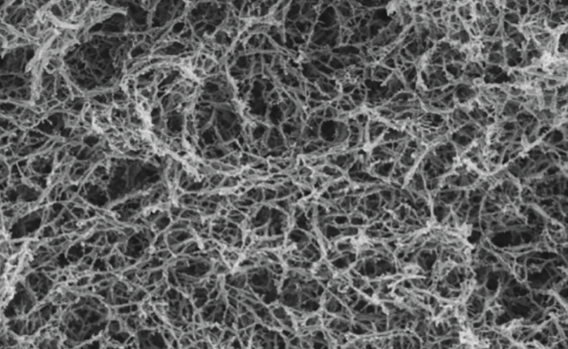Polymer Science
We conduct fundamental and applied research in polymer science. Below is the short description of ongoing research projects.
Nanofibrillar hydrogels

Many biological polymers form fibrillar hydrogels. Actin is the main element of the cytoskeleton, fibrin is a crucial element of thrombosis, and collagen is the constituent of the extracellular matrix. We study the mechanical and transport behavior of fibrillar hydrogels. These properties are of immense importance for biological and biomedical systems. For example, properties of fibrin hydrogels determine the behavior of blood clots. On the other hand, embolization of blood capillaries with hydrogels is an emerging therapy used to reduce blood supply to tumor sites and stop vascular bleeding. We are also interested in the synthesis and assembly of man-made biomimetic fibrillar hydrogels. We explore their applications is cell culture, drug screening and the development of skin care products.
Representative publications
Prince, E. et al. Nanofibrillar hydrogel recapitulates changes occurring in the fibrotic extracellular matrix. Biomacromolecules 22, 2352-2362 (2021)
Prince, E.; Kumacheva, E. Design and applications of man-made biomimetic fibrillar hydrogels. Nat. Rev. Mater. 4, 99-115 (2019)
Li, Y.; Kumacheva, E. Hydrogel Microenvironments for Cancer Spheroid Growth and Drug Screening. Sci. Adv. 4, eaas8998 (2018)
Li, Y. et al. Universal behavior of hydrogels confined to narrow capillaries. Sci. Rep. 5, 17017 (2015)
Polymers on nanoparticles

Polymer-tethered nanoparticles have a broad range of applications. We study the physico-chemical properties of polymer chains grafted to inorganic nanoparticles. We are specifically interested in the effect of confinement, surface curvature and phase separation in the polymer layer. We use this knowledge to surface-pattern nanoparticles to control their self-assembly and prepare nanoparticles for targeted applications.
Representative publications
Yi, C. et al. Self-limiting directional nanoparticle bonding governed by reaction stoichiometry. Science 369, 1369 (2020)
Rossner, C. et al. Staged surface patterning and self-assembly of nanoparticles functionalized with end-grafted block copolymer ligands. Angew. Chem. Int. Ed. 58, 27, 9269 (2019)
Galati, E. et al. Helicoidal patterning of nanorods with polymer ligands. Angew. Chem. Int. Ed. 58, 93123 (2019)
Choueiri, R. M. et al. Surface patterning of nanoparticles with polymer patches. Nature 538, 79 (2016)
Stimuli-responsive polymers

We conceptualize, design, synthesize and fabricate polymers that undergo shape change in response to external stimuli and have promising applications in soft robotics, drug delivery systems, sensing, and cell culture. Actuation occurs due to differential materials's swelling and is achieved by modulating its composition.
Representative publications
Li, Y. et al. Supramolecular nanofibrillar thermoreversible hydrogel for growth and release of cancer spheroids. Angew. Chem. Int. Ed. 56, 6083-6087 (2017)
Wu, Z. L. et al. Three-dimensional shape transformations of hydrogel sheets induced by small-scale modulation of internal stresses. Nat. Commun. 4, 1586 (2013)
Therien-Aubin, H et al. Multiple shape transformations of composite hydrogel sheets. J. Am. Chem. Soc. 135, 4834-4839 (2013)